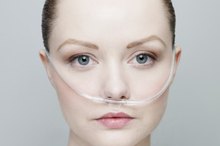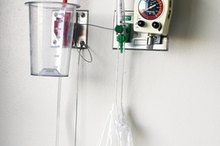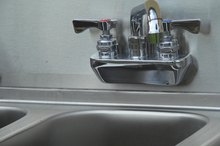Different Types of Oxygen Masks
The body needs oxygen to function properly and receives oxygen via the lungs to be metabolized in all cells of the body. Conditions affecting the lungs such as chronic obstructive pulmonary disease (COPD), including emphysema and chronic bronchitis, require oxygen therapy so that the body can get adequate oxygenation. Oxygen therapy can be implemented in a hospital setting or at home with a portable oxygen tank for people with chronic conditions. Delivery of oxygen by masks can vary depending on the amount of oxygen a person needs.
Nasal Cannula
Also called "nasal prongs," a nasal cannula is a two-pronged tube device attached to an oxygen source. The prongs sit at the entrance of the nostrils with the tube anchoring over the ears to hold it in place. Nasal cannulas deliver a low flow rate of oxygen mixed with room air and are appropriate for those with minimal respiratory distress and those requiring long-term oxygen use. According to Joan King, R.N., in the trade publication "Nursing," nasal cannulas deliver oxygen concentrations of 24 to 44 percent.
- Also called "nasal prongs," a nasal cannula is a two-pronged tube device attached to an oxygen source.
Simple Face Mask
How to Change Oxygen Cylinders Safely
Learn More
For a higher oxygen concentration delivery of 40 to 60 percent, a simple face mask is utilized. The mask fits over the nose and mouth with a metal piece conforming to the shape of the nose on top and an elastic strap around the head to keep the mask in place. The oxygen source attaches to the mask and exhalation ports allow for carbon dioxide escape as well as mixing delivered oxygen with room air. The mask can hinder some freedom compared to the nasal cannula and some people complain of feeling claustrophobic, according to Pruitt and Jacobs in "Nursing."
- For a higher oxygen concentration delivery of 40 to 60 percent, a simple face mask is utilized.
- The mask can hinder some freedom compared to the nasal cannula and some people complain of feeling claustrophobic, according to Pruitt and Jacobs in "Nursing.
- "
Reservoir Masks
Partial re-breather and non-breather masks are considered reservoir masks. These masks deliver higher concentrations of oxygen for people with serious respiratory conditions: 70 to 90 percent from a partial re-breather mask and above 90 percent from a non-re-breather mask. Both types of masks resemble the simple face mask except they have an attached reservoir bag. Reservoir masks have one-way valves to prevent outside air from entering. According to Mary E. Martelli, R.N., in the "Encyclopedia of Nursing and Allied Health," the reservoir bag of a partial re-breather mask conserves one third of exhaled carbon dioxide for use as a respiratory stimulant, while the reservoir of a non-re-breather mask collects increased concentrations of oxygen for breathing 3.
- Partial re-breather and non-breather masks are considered reservoir masks.
- These masks deliver higher concentrations of oxygen for people with serious respiratory conditions: 70 to 90 percent from a partial re-breather mask and above 90 percent from a non-re-breather mask.
Related Articles
References
- "Nursing"; How do I choose a supplemental oxygen delivery device?; Joan E.King; December 2003
- "Nursing"; Basics of oxygen therapy; William C. Pruitt; Michael Jacobs; October 2003
- "Encyclopedia of Nursing and Allied Health"; Nasal cannula/face mask application; Mary Elizabeth Martelli, R.N.; February 2005
- Things to Know When Using Oxygen Therapy. American Lung Association. August 23, 2018
- The Long-Term Oxygen Treatment Trial Research Group. A Randomized Trial of Long-Term Oxygen for COPD with Moderate Desaturation. The New England Journal of Medicine. 2016;375(17):1617-1627. doi:10.1056/NEJMoa1604344.
- American Lung Association. Supplemental Oxygen. 2017.
- Shah SA, Velardo C, Farmer A, Tarassenko L. Exacerbations in Chronic Obstructive Pulmonary Disease: Identification and Prediction Using a Digital Health System. Eysenbach G, ed. Journal of Medical Internet Research. 2017;19(3):e69. doi:10.2196/jmir.7207.
- Turan O, Ure I, Turan PA. Erectile dysfunction in COPD patients. Chron Respir Dis. 2016;13(1):5–12. doi:10.1177/1479972315619382
- Traveling with Oxygen. American Lung Association. October 3, 2018
- Nishimura M. High-flow nasal cannula oxygen therapy in adults. J Intensive Care. 2015;3(1):15. Published 2015 Mar 31. doi:10.1186/s40560-015-0084-5
- Abdo WF, Heunks LM. Oxygen-induced hypercapnia in COPD: myths and facts. Crit Care. 2012;16(5):323. Published 2012 Oct 29. doi:10.1186/cc11475
- American Thoracic Society. Patient Education Information Series. Oxygen Therapy. 2016.
Writer Bio
Based in Chicago, Jojo Genden is passionate about sharing her health and wellness expertise through writing since 2008. She holds a Bachelor of Science in biology from Rockford College, and a Bachelor of Science in nursing from Edinboro University of Pennsylvania. Genden is a registered nurse in the state of Illinois with a background in intensive care.









